Related Research Articles
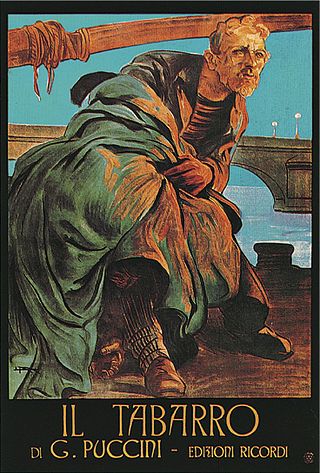
Il tabarro is an opera in one act by Giacomo Puccini to an Italian libretto by Giuseppe Adami, based on Didier Gold's play La houppelande. It is the first of the trio of operas known as Il trittico. The first performance was given on December 14, 1918, at the Metropolitan Opera in New York City.
Iris is an opera in three acts by Pietro Mascagni to an original Italian libretto by Luigi Illica. It premiered on 22 November 1898 at the Teatro Costanzi in Rome. The story is set in Japan during legendary times.
La leggenda di Sakùntala is a three-act opera by Franco Alfano, who wrote his own libretto, basing his work on Kālidāsa's 5th-century BC drama Shakuntala.
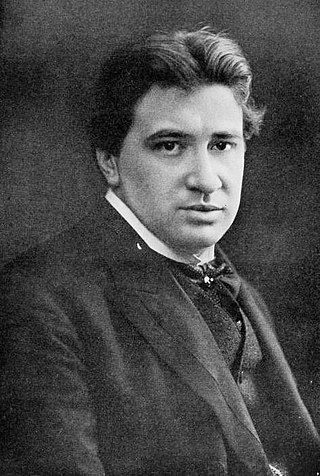
Il segreto di Susanna is an intermezzo in one act by Ermanno Wolf-Ferrari to an Italian libretto by Enrico Golisciani. The opera premiered in 1909 and is the most frequently performed of all of Wolf-Ferrari's works. The overture of the work has become a well known concert piece.The opera tell's the story of a husband who suspects his wife is having an affair after discovering she smells like cigarettes; only later to discover that her secret is that she is a smoker. Musicologist John C.G. Waterhouse, wrote the following: "Il segreto di Susanna owes its success partly to its disarming simplicity. Lasting barely 45 minutes, with only two singing characters, it is conveniently cheap to produce; and the slender but distinctive idea of the libretto, combined with the elegant if rather miscellaneous charm of the music, has an obvious appeal which even subsequent cancer research has not seriously undermined."
Guglielmo Ratcliff is a tragic opera in four acts by Pietro Mascagni to an Italian libretto by Andrea Maffei, translated from the German play Wilhelm Ratcliff (1822) by Heinrich Heine. Mascagni had substantially finished the composition of Ratcliff before the success of his first opera, Cavalleria rusticana.

Enrico di Borgogna is an opera eroica or "heroic" opera in two acts by Gaetano Donizetti. Bartolomeo Merelli, wrote the Italian libretto based on Der Graf von Burgund by August von Kotzebue.
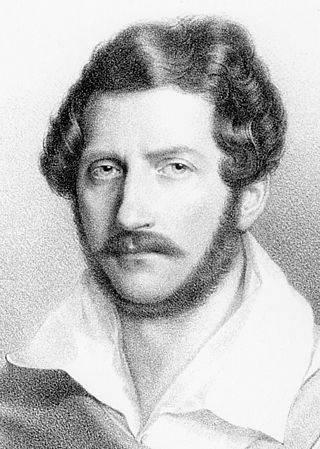
Sancia di Castiglia is an Italian opera seria in two acts by Gaetano Donizetti to a libretto by Pietro Salatino. It was first performed at the Teatro San Carlo in Naples on 4 November 1832, conducted by Nicola Festa.
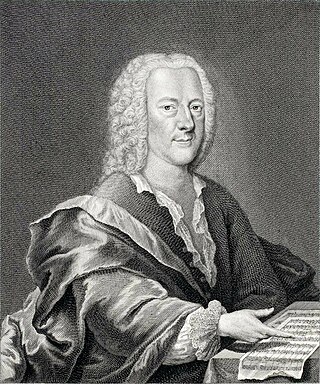
Orpheus is an opera in three acts by the German composer Georg Philipp Telemann. It was first performed in a concert version at the Oper am Gänsemarkt in Hamburg on 9 March 1726. The anonymous libretto is based on the 1690 opera Orphée by Michel Duboullay, originally set by the French composer Louis Lully. Most of the work is in German but it also contains passages in French and Italian drawn from famous operas by Handel and Jean-Baptiste Lully. The music to these words is Telemann's own, however. The manuscript score of Telemann's Orpheus was not rediscovered until the late 20th century.
Tigrane, o vero L'egual impegno d'amore e di fede is an opera seria in three acts by the Italian composer Alessandro Scarlatti with a libretto by Domenico Lalli. It was first performed at the Teatro San Bartolomeo, Naples, on 16 February 1715. It is regarded as one of Scarlatti's finest operas. As well as the serious main plot, there are also comic scenes involving the servants Dorilla and Orcone.

Lina Bruna Rasa was an Italian operatic dramatic soprano. She was particularly noted for her performances in the verismo repertoire and was a favourite of Pietro Mascagni who considered her the ideal Santuzza. Bruna Rasa created the roles of Atte in Mascagni's Nerone, Cecilia Sagredo in Franco Vittadini's La Sagredo and Saint Clare in Licinio Refice's 1926 oratorio, Trittico Francescano. She also sang the role of Tsaritsa Militrisa in the Italian premiere of Nikolai Rimsky-Korsakov's The Tale of Tsar Saltan.
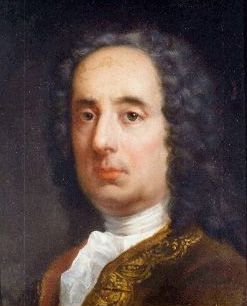
Griselda is an opera in three acts composed by Antonio Maria Bononcini. The opera uses a slightly revised version of the 1701 Italian libretto by Apostolo Zeno that was based on Giovanni Boccaccio's The Decameron. The opera was dedicated to Prince Maximilian Karl von Löwenstein, the Austrian governor of Milan, who died during the opera's world première on 26 December 1718 at the Teatro Regio Ducale in Milan. Nevertheless, Bononcini's opera was well received and enjoyed several revivals during the eighteenth century.

Brigida Banti, best known by her husband's surname and her stage-name, as Brigida Banti, was an Italian soprano.

Mese mariano is an opera in one act by Umberto Giordano. Its Italian libretto by Salvatore Di Giacomo was adapted from his play 'O Mese Mariano, which was in turn adapted from his novella, Senza vederlo. It premiered at the Teatro Massimo in Palermo on 17 March 1910. The opera is described as a bozzetto lirico and has a running time of 35 minutes. It tells the story of a woman who visits an orphanage to see her child. Racked with guilt at having abandoned him, she is unaware that he had died the night before.

Castle Agrazant is an opera composed by Ralph Lyford. It premiered on 29 April 1926 at the Cincinnati Music Hall. Castle Agrazant won a Bispham Memorial Medal Award in 1926.

Fosca is an opera seria in four acts by Brazilian composer Antônio Carlos Gomes to an Italian-language libretto by Antonio Ghislanzoni based on Luigi Capranica's 1869 novel La festa delle Marie.

Conchita is an opera in four acts and six scenes by composer Riccardo Zandonai. The work uses an Italian language libretto by Maurizio Vaucaire and Carlo Zangarini which is based on Pierre Louÿs's 1898 novel La Femme et le pantin. The work premièred in Milan at the Teatro dal Verme on 14 October 1911 with soprano Tarquinia Tarquini, who later married Zandonai in 1917, in the title role. Her portrayal was lauded by critics and she went on to perform Conchita at the Royal Opera, London (1912), the Cort Theatre in San Francisco (1912), the Philharmonic Auditorium in Hollywood (1912), the Heilig Theatre in Portland (1912), the Metropolitan Opera House in Philadelphia (1912), the Chicago Grand Opera Company (1913), and the Teatro di San Carlo in Naples (1913). The opera was published by G. Ricordi & Co in 1912.

Gloria is a tragic opera in three acts by Francesco Cilea with an Italian libretto by Arturo Colautti. A variation on the Romeo and Juliet story and set in 14th century Siena, the libretto is based on Victorien Sardou's 1874 play La Haine (Hatred). The opera premiered on 15 April 1907 at La Scala conducted by Arturo Toscanini with Solomiya Krushelnytska in the title role. Gloria was a failure at its premiere when it was withdrawn after two performances and fared little better in the 1932 revised version, although there have been two late 20th century revivals. It proved to be Cilea's last staged opera. In the 43 years following the premiere of Gloria he worked on two or three further operas which were never performed and continued to compose chamber and orchestral music.

Sì is an operetta in three acts composed by Pietro Mascagni to a libretto by Carlo Lombardo with verses by Arturo Franci. The libretto is based on Lombardo's operetta La duchessa del Bal Tabarin and Felix Dörmann's libretto for Majestät Mimi set by Bruno Granichstaedten in 1911. Mascagni's only venture into operetta, it premiered on 13 December 1919 at the Teatro Quirino in Rome. The operetta takes its name from its central character, Sì, an actress at the Folies Bergère, so called because she could never say no.
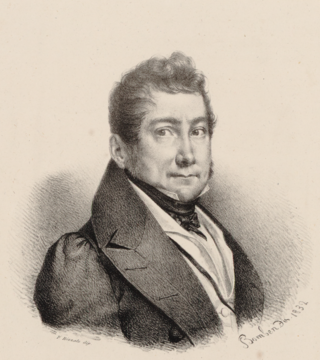
Caterina di Guisa is an opera in two acts by Carlo Coccia to a libretto by Felice Romani based on the 1829 play Henry III and His Courts by Alexandre Dumas. Caterina di Guisa premiered on 14 February 1833 at the Teatro alla Scala in Milan with triumphal success. A revised version, probably prepared to exploit at its best the different cast, was presented on 15 June 1836 at the Teatro Carignano in Turin. This opera is characterized by an "intensely dramatic score, rich in power and originality" and by a "heartrending finale".

Maria Carbone was an Italian operatic soprano. She created the lead female roles in two of Gian Francesco Malipiero's operas: the title role in Ecuba and Cleopatra in Antonio e Cleopatra.
References
- 1 2 Warrack, John; West, Ewan (1996). "Isabeau". The Concise Oxford Dictionary of Opera. Oxford University Press.
- 1 2 Girardi, Michele [in Italian] (1992). "Isabeau". In Sadie, Stanley; Tyrrell, John (eds.). The New Grove Dictionary of Music and Musicians (2nd ed.). London: Macmillan Publishers. ISBN 978-1-56159-239-5.
- ↑ "Isabeau", italianopera.org
- ↑ Casaglia, Gherardo (2005). "Isabeau, 2 June 1911" . L'Almanacco di Gherardo Casaglia (in Italian).